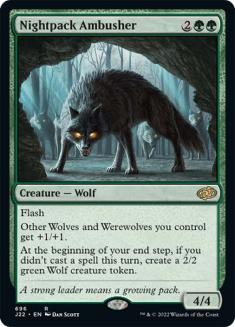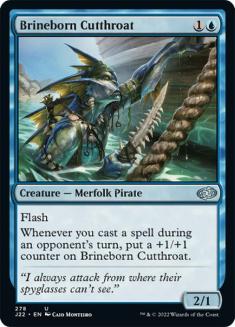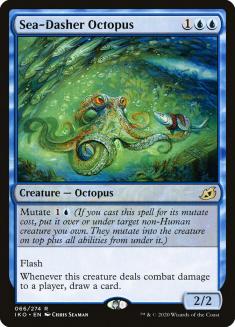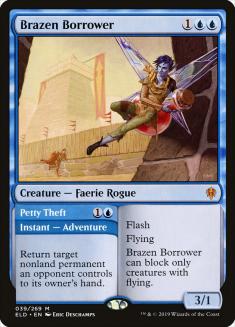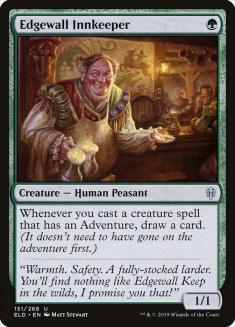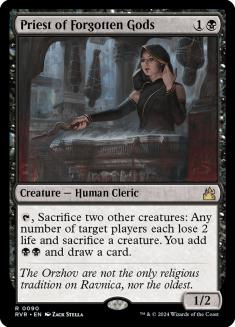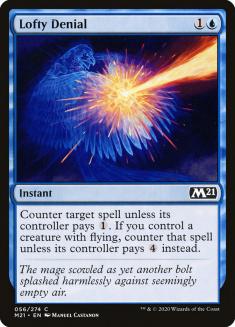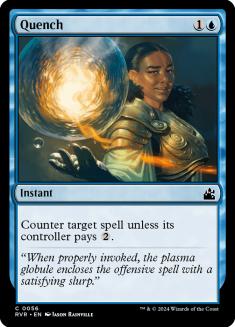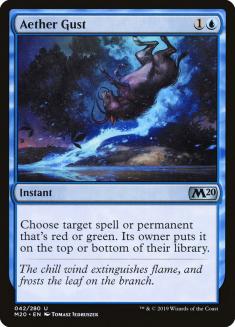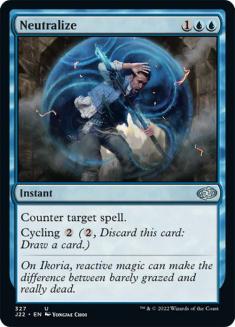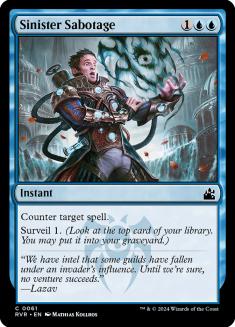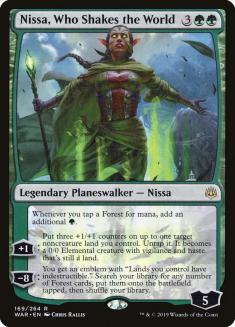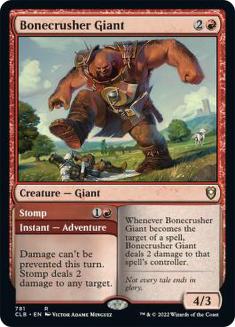At this point in time, Sultai Ramp has definitely established itself as the deck to beat in Core Set 2021 Standard. It’s got that rare combination of “most played” and “best win rate” that usually ends up lending itself to a dominant performance. However, the format is still relatively new, and many strategies are still under-explored.
One of the strategies that I believe could be good versus Sultai Ramp is Flash. Flash decks are traditionally strong versus tap-out decks that rely on expensive cards to win, and many Sultai Ramp decks have been adapting their builds to be stronger in the mirror, which means they have almost no removal in Game 1 and could be more vulnerable to cards like Nightpack Ambusher or Brineborn Cutthroat.
Regardless of which version of Flash you play, your game plan is usually the same — you want to stick a threat and then counter everything meaningful that your opponent does until they’re dead. If your deck is green, that threat is usually Nightpack Ambusher; if it’s not, then you have Brineborn Cutthroat. All versions of the deck run a lot of instants and Flash cards (hence the name), which means you can usually pass the turn with open mana and react to what the opponent does — if they play something that can cause trouble, you counter it, and if they don’t then you advance your own battlefield.
Flash decks will usually not be as powerful as the other decks, and they will have cards that scale poorly in the late-game (such as situational counterspells like Quench or weak, cheap creatures), so they are commonly referred to as Tempo decks — they try to win by countering expensive spells with cheap spells, which allows them to develop their battlefield and deal damage while the opponent isn’t doing anything. When a Flash deck loses, it often looks unplayable — it falls behind early and its counterspells don’t match up to what the opponent is doing, so it just dies without resistance. When a Flash deck wins, it’s often the opposite — it looks unbeatable. Against decks with expensive cards, it’s not rare that you win the game without your opponent having ever resolved a spell; a Nightpack Ambusher attacks for four, then seven, then ten, and that’s already enough to win the game, so you don’t need to draw that many counters to make this happen.
Right now, there are common directions one can go with Flash decks. They all follow the same trends and general patterns, but differ in how they deal with permanents and how much raw power they have.
Simic Flash w/out Nissa, Who Shakes the World
Creatures (22)
- 3 Frilled Mystic
- 4 Spectral Sailor
- 4 Nightpack Ambusher
- 4 Brineborn Cutthroat
- 4 Brazen Borrower
- 3 Sea-Dasher Octopus
Lands (11)
Spells (27)
Sideboard

Daniel plays both Brineborn Cutthroat and Nightpack Ambusher, which is not the most usual (but still not crazy, as I’ve seen it before in other lists). This list is the most “Flashy” one of them all — it plays completely at instant-speed and even has Sea-Dasher Octopus for a Mono-Blue Aggro impersonation. It wastes absolutely no slots with removal spells — its only battlefield interaction is Brazen Borrower (plus one copy of Sublime Epiphany). This means it’s the strongest versus heavy spell-based decks, as it’s going to have no dead cards and the most cohesive gameplan.
To balance things out, there are two downsides to the Simic list. The first is that it’s the weakest against creatures (particularly cheap ones). A card like Questing Beast isn’t going to be the biggest deal, as you can just counter or bounce it, but a card like Edgewall Innkeeper is a nightmare. Every cheap creature is a problem — Knight of the Ebon Legion, Gutterbones, and Scorch Spitter are all cards you don’t want to see opposite you with the Simic version — but the utility creatures in particular are the biggest problem since you can’t even block them. You can reasonably play a Nightpack Ambusher and blank all opposing Scorch Spitters forever, but what do you do against Priest of the Forgotten Gods or the aforementioned Edgewall Innkeeper? These cards can win the game singlehandedly without ever attacking.
The second downside is that your sideboard is pretty bad. You’re already pre-sideboarded versus the control decks, so even though you’re bringing in cards you don’t gain that much there, since the cards you’re removing aren’t bad, and the cards to combat your creature problems simply don’t exist. You can play Aether Gust and Lovestruck Beast, and those will be good at stopping aggression, but they will not solve Edgewall Innkeeper or Priest of the Forgotten Gods.
All in all, I do not think the Simic version is the best. I believe you’re marginally better versus the control decks but significantly worse versus the aggro decks, and the trade-off is not worth it. If you do want to play straight Simic, though, then I would make a couple of changes.
The first change I’d make is to play Lofty Denial instead of Quench. I think the difference between one and two in the early-game is smaller than the difference between two and four in the mid-late game, and this deck has four Spectral Sailor, four Brazen Borrower and two Shark Typhoon to enable it, so I think it’s a bit better.
The second change is I’d play maindeck Aether Gust. I believe there are enough copies of Uro, Titan of Nature’s Wrath and Nissa, Who Shakes the World going around in the format to justify it. This is a tempo deck, so Aether Gust is even better than normal here, as you can aim to close out the game before they can replay whatever it is that you target.
The third change is swapping Neutralize for Sinister Sabotage. I’m not 100% convinced it’s better, but I think in a deck like this, that wants to chain counterspells, it’s the superior choice. Neutralize is better for decks like Bant Control who simply want access to some counterspells versus random bombs and will want to cycle them a lot more.
The final change is the mana base. This deck doesn’t have Nissa, so there’s no justification for playing a Triome over a Temple of Mystery since the scry is simply better than the cycling. I would also add a land.
This is what I would play for Simic Flash (though, again, this is not my preferred version):
Creatures (21)
- 3 Frilled Mystic
- 4 Spectral Sailor
- 4 Nightpack Ambusher
- 4 Brineborn Cutthroat
- 4 Brazen Borrower
- 2 Sea-Dasher Octopus
Lands (12)
Spells (27)
Sideboard

Simic Flash w/ Nissa, Who Shakes the World
Creatures (18)
Planeswalkers (4)
Lands (11)
Spells (27)

This is another Simic version, but it plays out very differently from the first one I posted, because it has four copies of Nissa and a lot of acceleration. This makes this deck more powerful overall, but less effective at executing its gameplan, as it has fewer flash threats and fewer counterspells. Ultimately, it has more cards that win the game on their own, so it’s better versus disruption as well.
As for Nissa, I like it in the deck. I think that, as far as tap-out cards go, it’s one of the better ones since it still leaves you mana to be able to cast something like Negate, Quench, or Aether Gust and it kills them very quickly (similar to Nightpack Ambusher). Perhaps more importantly, Nissa is a good punishment for people who tap out on their turn to fight your flash threats. For example, sometimes you play a Nightpack Ambusher and your opponent fights over it, with Mystical Dispute or a removal spell, and then you untap and have nothing to follow it up with so you actually haven’t accomplished anything. Having Nissa in your deck means you can profit from these end-of-turn fights.
I prefer a version with Nissa over a version without, but I find Martin’s list a bit schizophrenic, as it’s trying to play Brineborn Cutthroat alongside the Nissa package when the cards really don’t go well together. If you have Brineborn Cutthroat, you need instants to support it — not Paradise Druid, Nissa, and Wolfwillow Haven. If you have Nissa and the accelerants, you need powerful spells to be able to play with all your mana. If you ramp to six mana on Turn 4 and then draw a Brineborn Cutthroat, that’s a disaster, so I don’t think the strategies are compatible.
If I were to play a Simic Flash deck with Nissa, this would be my list:
Creatures (17)
Planeswalkers (4)
Lands (13)
Spells (26)
- 7 Forest
- 5 Island
- 2 Negate
- 3 Quench
- 2 Aether Gust
- 2 Mystical Dispute
- 2 Wolfwillow Haven
- 2 Shark Typhoon
- 1 Sublime Epiphany
Sideboard

This version has two Hydroid Krasis and a Sublime Epiphany (plus Castle Vantress), so it has a lot more to do with the mana. Having accelerants also makes it more viable to play Elder Gargaroth, which is good in matchups like Mono-Red Aggro.
Temur Flash
Creatures (15)
Planeswalkers (2)
Lands (21)
Spells (22)

Marcio Carvalho’s deck is sort of a cross between the two builds — it plays Nissa as a way to punish an opponent who taps out, but it doesn’t make it its primary plan; it’s still a Flash deck.
The big difference between this build and the others is the presence of red removal. Having Bonecrusher Giant in your deck means you are much better equipped to deal with the utility creatures that the Simic versions of the deck are hopeless against, which makes you considerably better versus decks that play them. Your mana base does get worse, which means more damage and more lands that enter the battlefield tapped, so you still suffer versus, for example, a Mono-Red Aggro deck.
You also get a much more powerful sideboard if you add red, as having a lot of potential removal spells gives you the option to morph into a control build — you get to take out a lot of the counterspells and simply replace them with removal spells. Having removal also allows you to sideboard Uro, as you have ways of prolonging the game that put cards in the graveyard.
Personally, I like this build more than the straight Simic versions. I think you gain more versus the creature decks by having removal than you lose by having a worse mana base (especially since many Simic versions run Triomes anyway). I think this build of the deck is pretty solid, but I would still change a couple of things. I don’t like Chemister’s Insight, for example (I think this is a deck that doesn’t want to spend its time with Divinations). I would also add a couple more powerful spells (Hydroid Krasis and a third Nissa) over some excessive counterspells and change the sideboard a little bit.
Creatures (17)
- 2 Hydroid Krasis
- 3 Frilled Mystic
- 2 Paradise Druid
- 4 Nightpack Ambusher
- 4 Bonecrusher Giant
- 2 Brazen Borrower
Planeswalkers (3)
Lands (21)
Spells (19)

Sultai Flash
Then, there’s the list that I’ve liked the most lately — Sultai Flash. This is very similar to the Temur Flash version, except you have black removal instead of red.
Creatures (14)
Planeswalkers (3)
Lands (21)
Spells (22)

This deck operates almost identically to the Temur version; it’s a flash deck Game 1 that gets to sideboard into a control deck in Game 2. This is not so different than what the Sultai Control deck does, except they start with Uros and discard and you start with Nightpack Ambusher and counterspells.
I think there are pros and cons to playing black removal over red removal, but ultimately the black removal wins out. It’s much better versus any big creature (Nightpack Ambusher, Uro, Shark Typhoon tokens, Winona, Joiner of Forces, etc) and better versus Nissa (since you get Noxious Grasp), and it’s worse versus generic control decks like Grixis and Azorius, since your removal doesn’t double up as a threat. Given that I don’t expect many people to be playing Grixis and Azorius, I think being able to kill these bigger creatures wins out, which gives the edge to Sultai.
Ultimately, I think both three-color versions are better than the Simic ones — the mana is not much worse and the benefits of being able to kill a utility creature and have a real sideboard are both extremely valuable. I think Sultai is better positioned than Temur right now, so that’s the version of Flash I’d play.


